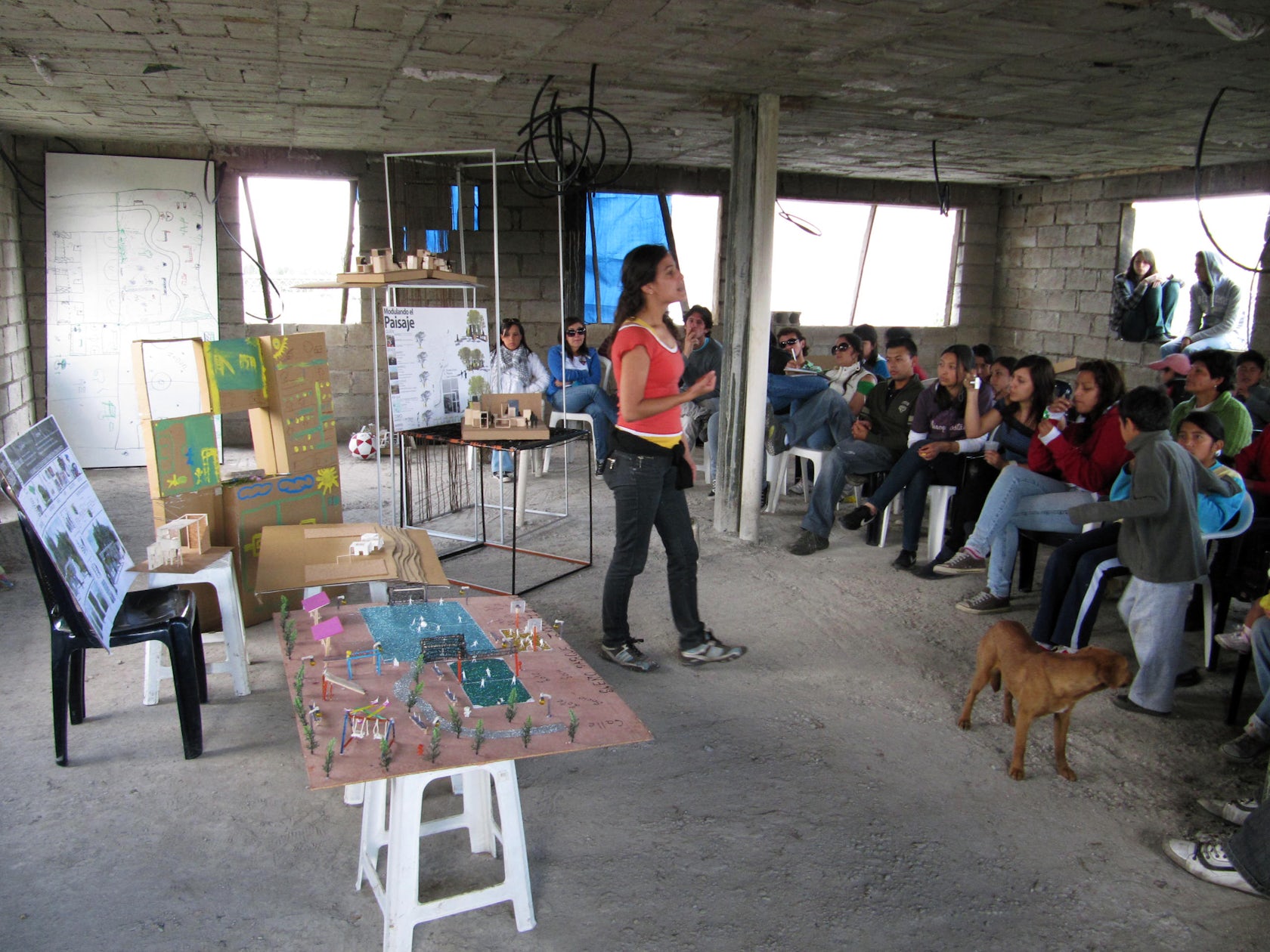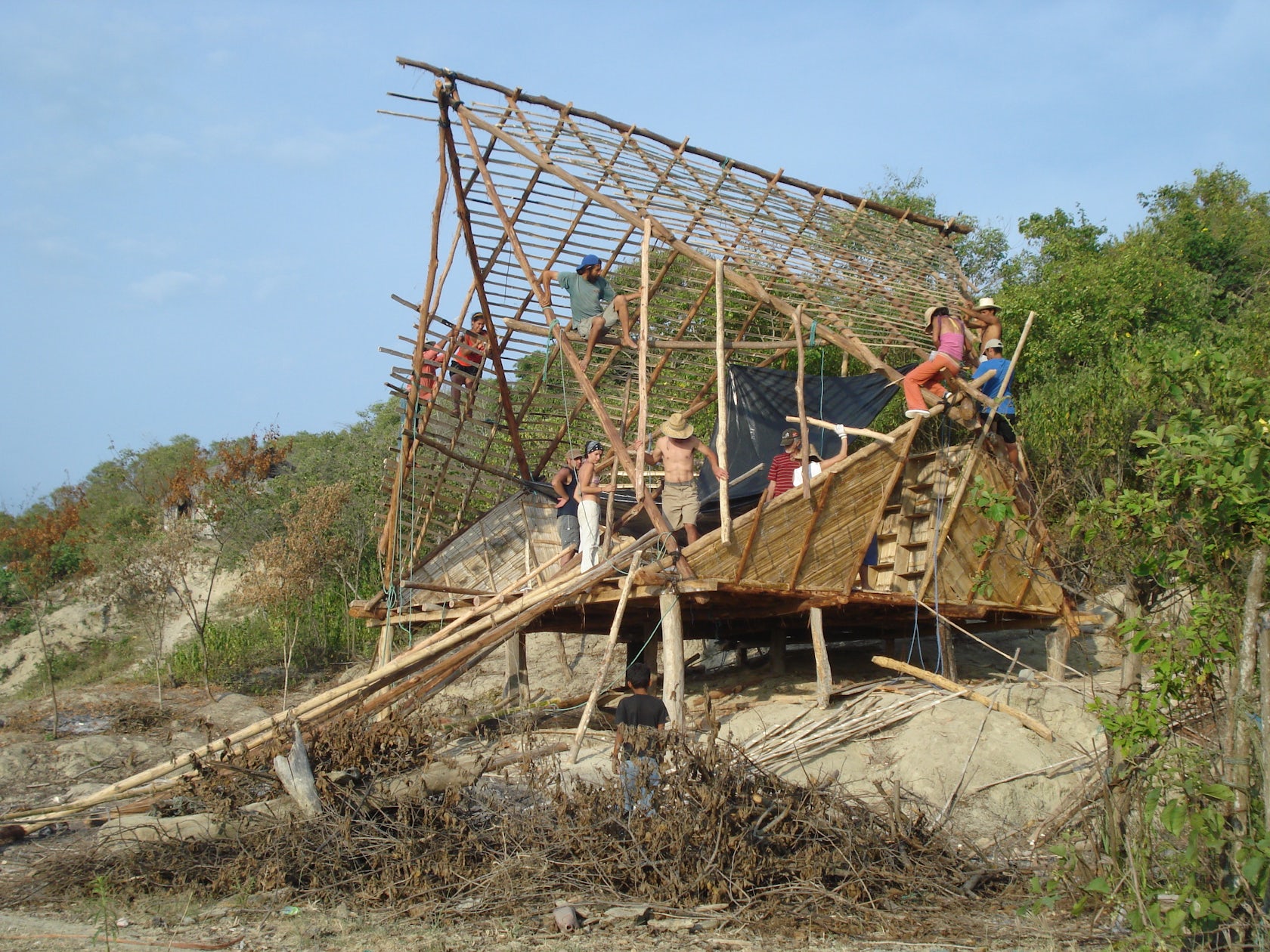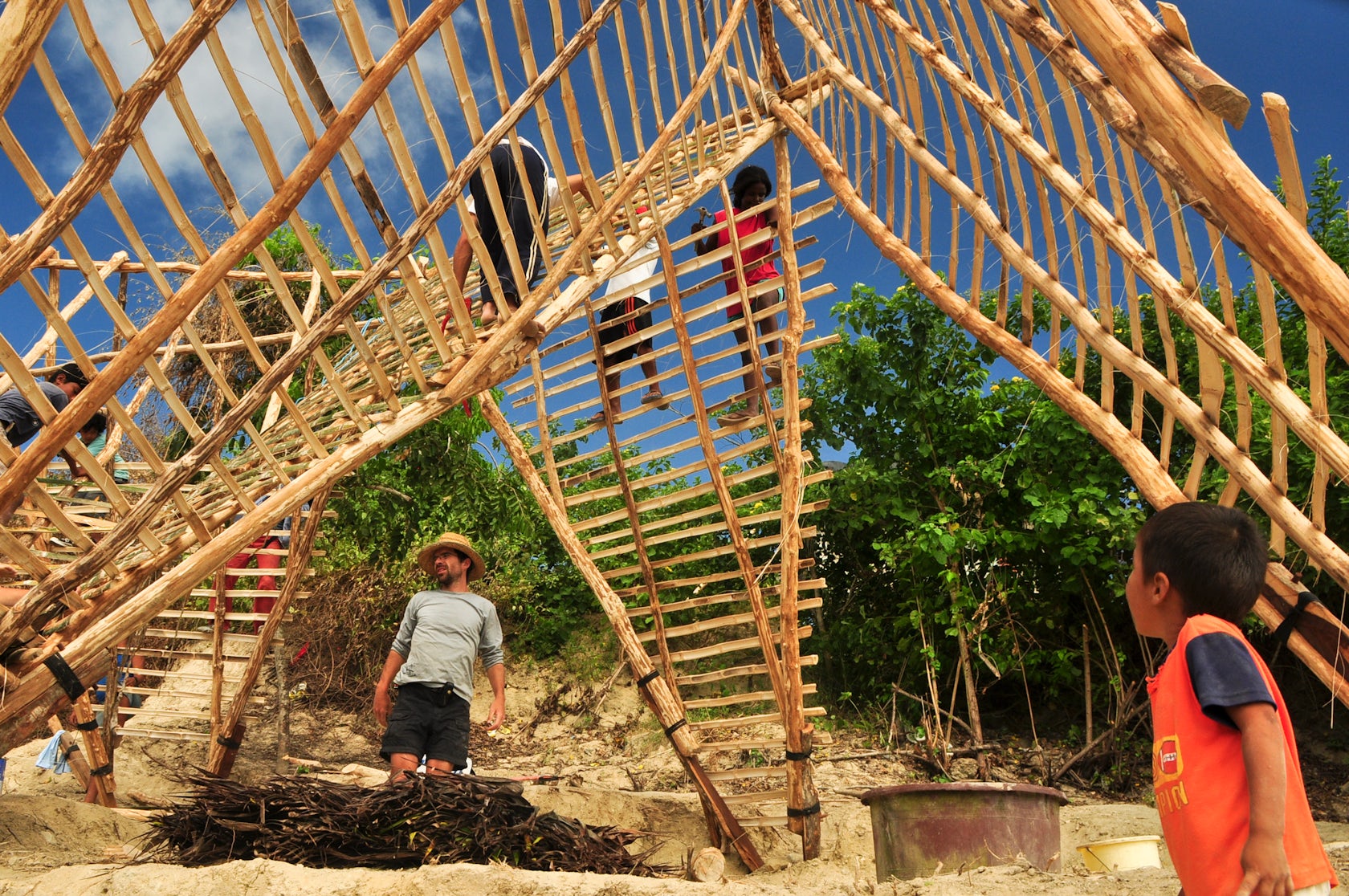“We see our process architecturally as an under-construction thought or philosophy,” conclude David Barragán and Esteban Benavides, speaking of their Ecuadorian firm Al Borde. Based in the the city of Quito, the nine-year-old firm of four members, including David, Esteban as well as Pascual Gangotena and Marialuisa Borja, displays a vibrant energy and explorative curiosity that manifests itself in many forms, from built projects to workshops, exhibitions, public actions and, even, downloadable DIY building instructions. The establishment of a practice that is perpetually a work in progress is a conscientious action taken by its members. Its ability to be adaptive and flexible is the foundation that makes its work possible.
Al Borde’s practice is chiefly motivated by its interface with communities, integrating numerous persons of varying occupations and social standing into every step of a project’s process. While the team often accepts commissions for private projects, workshops and collaborative social productions are inherent components of its practice.
In a workshop entitled ‘Taller Particular’ (Particular Workshop) that sought to create community programming and the construction of a community center for a slum in Quito, the firm called on the joint knowledge and efforts of a university, architecture students, an anthropologist and members of the local community as well as themselves, the architects. Projects such as these have taught the members of Al Borde that collaboration is much more useful than a specific set of skills or knowledge, “that one plus one is not two, but more — because of the incalculable multiplier effect of teamwork.”

© Al Borde arquitectos

© Al Borde arquitectos
Taller Particular, Quito, 2012
Listening and learning from the existing elements of a project’s context have revealed themselves to be the primary tools necessary for the team’s approach. “We don’t believe in this kind of structure of business like mission, vision, objectives because we see that as very rigid,” David explains, “we have a structure of our office of our practice … but, at the same time, we have the complete openness to change everything in a very quick way. We don’t have any problem with changing our dogmas.”
Al Borde’s dedication to pliability in its practice was largely informed by a project it accepted early on during the firm’s development in 2009, which presented it with a particularly unusual and extreme set of conditions. The commission was to design and construct a school, which it named ‘Escuela Nueva Esperanza’ (New Hope School), in a rural community in the beach town of Cabuyal, Ecuador, for which there was only $200 to carry out the project.

© Al Borde arquitectos
Escuela Nueva Esperanza, Cabuyal, 2009
The community on the beach does not function the way those of the towns or cities of Ecuador does; it does not use money within its community; rather, the members of the community fish and farm the land and utilize a bartering system. In this way, it is an entirely self-sufficient community, and its relationship with nature is extremely significant to its way of life. In approaching the design of the school, the team had originally presented the idea to use recycled materials, but the schoolteacher who was directing the project advised them: “Recycled materials? Are you insane? Recycled materials are an option for you in the city because you are producing a lot of waste, but at the beach, we are not producing waste.”
The schoolteacher’s words presented a decisive turning point for the young architects. They understood that “the context and the possibilities for any project are very very specific” and that the solution to any given project’s set of demands lies mainly within the experience of the client rather than the preexisting knowledge acquired by the architects. As it began to embrace the lessons from the community as guidelines for its approach, this method opened pathways to solutions that the firm has dubbed “common-sense sustainability”: utilizing materials and methodologies that are readily available and familiar to the clients. Esteban explains that the firm’s “common sense came from the lack of options. We didn’t have the option to waste a lot of energy in things that are not completely necessary.”

© Al Borde arquitectos

© Esteban Cadena
Escuela Nueva Esperanza, Cabuyal, 2009
The lack of resources at hand for the project forced the young firm to rely on the community in ways that many architects would find atypical: “the community was involved within the construction because it was impossible to do it without [them].” Thus, the school was constructed using timber, bamboo and straw from the surrounding area, materials the community had been using to build shelters for years. They were very active in the construction process, employing building methods that they were familiar with; it was only the “conception and conceptualization of the space” that the architects supplied to the process.
When the firm was asked back to build an extension to the school in 2011, ‘Esperanza Dos,’ the team began to think actively about how the requirements of the project could be effectively utilized for the community. Barragán explains that, as they started thinking about ‘Esperanza Dos’, they were “working with an anthropologist exploring different kinds of methodologies of participation,” and they decided to “involve the community in the decision-making system to define the specific parts of the spaces.”

© Esteban Cadena

© Andrea Vargas
Esperanza Dos, Cabuyal, 2011
Their ultimate goal was to foster an equal dialogue between themselves and the members of this community in the design and construction process so that the end result would reflect the needs and preferences of the people who would use the structure and so that the firm’s involvement in the community’s efforts to make improvements in its village would eventually be unnecessary.
Returning to Cabuyal for the third time to complete another extension for the school in2013, Al Borde witnessed some remarkable results from its engagement efforts in ‘Esperanza Dos.’ “All of the processes we did involved with these people created a kind of interest in experimenting with construction,” remarks David. “They began to experiment with forms and structure … For us, it was amazing to see a house built by a fisherman — who doesn’t know how to read or write — that has a decagon floor plan and double-height spaces.”

© Al Borde arquitectos
The house a fisherman named Jimmy designed for his family.
The motivation and self-sufficiency demonstrated by the community of Cabuyal after the second project inspired Al Borde to completely rethink its involvement for the third extension. Instead of helping to construct the extension by advising the design and building process, the team “decided to work with them in a school for architecture,” teaching them the necessary skills to approach the development of further architectural endeavors, without the need of any professional’s direct control or instruction.

© Al Borde arquitectos

© Al Borde arquitectos
Última Esperanza, Cabuyal, 2013
While the ‘Escuela Esperanza’ projects were quite extreme in context, Al Borde makes a concerted effort to apply the lessons it has gathered from this formative experience to the more urban-oriented projects it has since been engaged in. “In some way, the will [the Cabuyal community] showed [to] be independent provoked us to try to offer the same independence in the communities we worked with after this project … When we work with communities, we try to do all the things we have to do so that, at some point, we will become unnecessary.”
The team does not wholly consider itself architects; rather, it sees its architectural production as a particularly useful mode for solving the kinds of problems it is interested in. “When we accept a client, we are not thinking specifically about whether the project is architectural or not … we are thinking about ways of living … The business of architecture is very interesting, but it is very small compared to the business of life.” The team’s dedication to a flexible and open approach to the kinds of projects it accepts — as well as its methodologies — make it possible for it to acquire solutions in unexpected scenarios.
“We are always prepared to face life without hope and without fear, without hope of success and without fear to fail,” says Al Borde. It cites Brazilian architect Oscar Niemeyer, who advised architects to remember that “life is more important than architecture.” As Esteban explains, “I think that is a very important idea for us. We are not an architecture studio; we are people who are wondering about what is necessary in life and what is necessary in our society. We do projects that are sometimes architectural, sometimes with organizations, sometimes with street art, but, ultimately, it is fun.”

Escuela Nueva Esperanza, Cabuyal, 2009
Interview quotes have been edited for clarity. For more images of and insight on Al Borde’s innovative projects, explore its in-depth firm profile, now.




